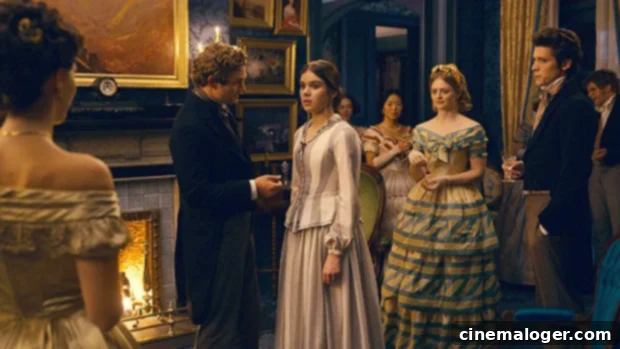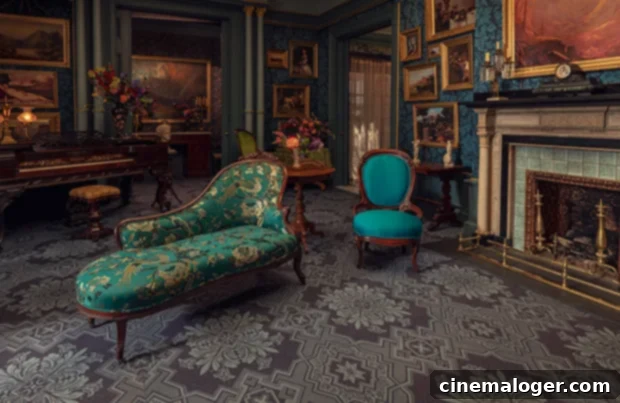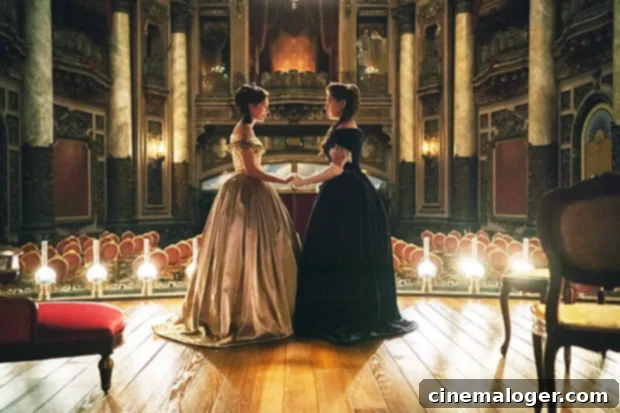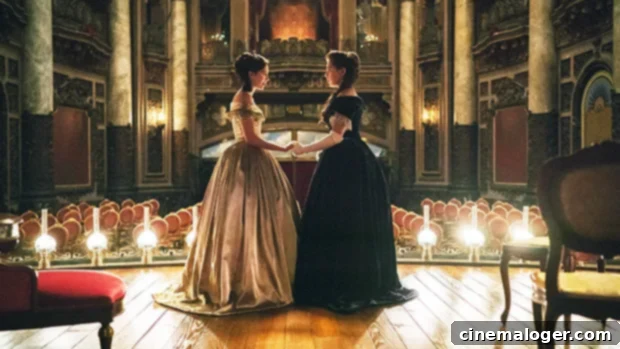Unveiling the Opulent Worlds of ‘Dickinson’: Production Designer Neil Patel on Crafting Seasons 2 and 3
In the vibrant and anachronistic world of Apple TV+’s hit series Dickinson, the journey of Emily Dickinson, brilliantly portrayed by Hailee Steinfeld, is not merely a poetic evolution; it’s a visual odyssey. As the show progressed into its second season, Emily’s internal and external worlds expanded dramatically. While the inaugural season offered glimpses of adventurous excursions to Walden Pond, the lively circus, and even a fantastical, sparsely-attended funeral, season two ofDickinson delved into a realm of significantly greater opulence and diverse locales, all set against the backdrop of pre-Civil War America.
This ambitious expansion was meticulously brought to life by production designer Neil Patel, who joined the series for its second installment. Patel, a seasoned professional with a rich background in both theater and film/television design, swiftly became the visionary behind the show’s intricate aesthetic, shaping not only the lavish designs of season two but also laying the groundwork for the upcoming third season. His arrival marked a pivotal moment in the series’ visual development, bringing a fresh perspective while maintaining the show’s distinctive blend of period authenticity and contemporary flair.
Patel shared his initial enthusiasm for the project, stating, “I watched the first season and was absolutely in love with the show.” He elaborated on what drew him to Dickinson, highlighting the unique “creative friction between the contemporary dialogue and music and the beautiful period look,” a stylistic choice that resonated deeply with his artistic sensibilities. Working in close collaboration with series creator Alena Smith, Patel was instrumental in designing the pivotal scenes that would come to define the season’s grand scale. His designs spanned a diverse array of settings, from the grandeur of a Boston Opera House to the serene and somewhat unconventional environment of a New England water cure establishment. Central to this new visual landscape was The Evergreens, depicted as the ultimate nexus of New England literary life by Sam Bowles, and historically the actual home of Austin and Sue Dickinson in Amherst. Patel’s meticulous approach ensured that each location felt authentic yet imbued with the show’s signature playful anachronism, truly expanding Emily’s universe.

In a candid conversation, Neil Patel offered insights into the creative process behind his designs for season two. He generously shared the inspirations that guided his aesthetic choices, revealed fascinating “Easter eggs” hidden within the opera episode—a personal favorite for many viewers—and provided tantalizing hints about the transformative visual landscape awaiting Emily and the audience in the much-anticipated third season. His discussion illuminated the depth of thought and artistic detail invested in every frame of the series.
Working with Visionary Creators: Alena Smith and Hailee Steinfeld
Dickinson is famously spearheaded by two exceptionally driven and creative women: series creator and showrunner Alena Smith, and its star and executive producer, Hailee Steinfeld. When asked about the experience of collaborating with these influential figures and their overarching vision for the season, Patel expressed profound admiration for their talent and leadership.
“Alena obviously has a very strong and unique vision for the show,” Patel affirmed, acknowledging her foundational role in shaping the series’ distinctive identity. He further praised her as “a wonderful and generous collaborator,” emphasizing the collaborative and enjoyable nature of their working relationship. Their shared objective, he explained, involved a delicate balance: “We are always looking out for historical truth and detail, but also looking to give the show its own visual style.” This approach ensures that while the series is grounded in historical context, it simultaneously maintains a unique and contemporary aesthetic that is uniquely *Dickinson*.
Patel elaborated on how Emily’s character influences his design process, even without direct interaction with Hailee Steinfeld. “The show is seen through the lens of the extraordinary artist Emily Dickinson, who Hailee so brilliantly embodies,” he noted. Despite not interacting with Steinfeld during the design and production stages, Patel consistently considers her portrayal. “I’m always imagining the sets and scenes with her sensibility and take on the character in mind,” he explained, ensuring that the visual environment resonates with Emily’s nuanced personality and internal world, truly making the sets a reflection of her journey.
Crafting The Evergreens: Beyond the Homestead’s Familiarity
One of the most striking aspects of season two was the audience’s journey beyond the familiar confines of The Homestead, particularly to The Evergreens, Austin and Sue’s elaborate residence situated just across the lawn. This expansion significantly broadened Emily’s immediate world. When questioned about the extent of his team’s work on The Evergreens and the balance between historical accuracy and artistic interpretation, Patel provided illuminating details.
“Yes, we built the entire ground floor of Evergreens, including both the interior and exterior!” Patel confirmed, highlighting the monumental effort involved. He clarified the blend of authenticity and creative liberty: “The ground plan and Victorian Italianate Villa style is based on the real Evergreens, which you could recognize if you visited it in Amherst.” This foundational accuracy provides a genuine connection to the historical site. However, Patel then described the artistic enhancements: “I took liberties with the palette and interior detailing to make it more luxurious and to support the story of Sue’s elaborate salons.” These intentional deviations included “The tall ceilings, columns and fabric wall-coverings are not things you will see in Amherst.” These elements were consciously introduced to visually elevate The Evergreens, contrasting it with the Dickinson Homestead and underscoring Sue’s sophisticated social aspirations and the evolving dynamics within the family.

The Boston Opera House: A Masterpiece of Transformation for ‘Split the Lark’
Among the many visually stunning episodes of the season, “Split the Lark,” set within a grand Boston Opera House, stood out as a particular highlight. The remarkable feat of transforming a modern movie theater lobby in New Jersey into a convincing 19th-century opera house captivated audiences and begged for an explanation of the intricate process involved.
Patel meticulously recounted the challenging yet rewarding transformation. “When we scouted the Loews Theater in Jersey City, we first looked at the actual theater, which was too big and in too much disrepair to work for us,” he explained. The eureka moment arrived unexpectedly: “As we were leaving through the lobby, I noticed that its horseshoe plan and ornate mezzanine had the bones to be the opera house.” This initial spark of inspiration led to an ambitious plan. The team had to “build a stage and completely transform the main floor into the orchestra level of the opera house,” a task that was made feasible by the lobby’s inherent architectural grandeur, which Patel deemed “perfect.” He drew upon personal experiences, recalling, “I had spent some time as a student in Milan where I regularly saw operas at La Scala from the peanut gallery.” This firsthand immersion informed his vision, allowing him to confidently assert that “this lobby could create the ambiance of an opera house that would really convey the sense of glamour and opulence that would enchant Emily,” effectively transporting both the character and the audience into a bygone era of theatrical splendor.
Visual Storytelling: Opera Design Mirroring The Evergreens
During the opera sequence, Austin’s astute observation to Sue—that the production on stage bore a striking resemblance to one of her lavish salons—was a subtle yet powerful detail. This prompted a question about the intentionality behind the opera’s design and its connection to The Evergreens.
Patel confirmed this deliberate artistic choice. “Yes, it was!” he stated. He elaborated on the narrative context: “The opera they are seeing is La Traviata, and in my prep, I had all the scripts, so I knew that Emily would conflate Sue’s parlor with Violetta’s parlor in the opera.” This understanding allowed him to weave a visual thread between the two seemingly distinct worlds. To achieve this, Patel explained, “I looked to European parlors to influence the design of the Evergreens, and the palette and structure of the stage set is keyed off of that design.” This meticulous planning ensured that the visual echoes were not accidental but deeply embedded in the storytelling. To further cement this thematic connection, Patel pointed out a subtle “Easter egg”: “You may have also noticed that Violetta’s gold dress is very similar to Sue’s gold dress in the first Evergreens scene in 201,” a detail that underscored the parallel between Sue’s social aspirations and Violetta’s dramatic life, enriching the viewing experience for attentive audiences.
Illuminating the Past: The Chandelier Challenge
Within the grandeur of the transformed opera house, one particular element repeatedly drew the eye: a magnificent chandelier. Given that the theater itself dated back to the 1920s, it was highly probable that the chandelier was originally electric, posing a potential anachronism for a 19th-century setting. The question arose as to whether this presented any challenges for Patel and his dedicated team.
Patel candidly addressed this common production hurdle. “We often deal with this problem in location shooting,” he acknowledged, confirming the electric nature of the fixture. However, he quickly praised the ingenious solution orchestrated by the production’s technical departments: “thanks to the brilliant electrics and visual effects team with the right bulbs and some work after the footage was shot the lights appear to flicker like candles.” This meticulous attention to detail, combining practical effects with post-production wizardry, ensured that the modern electrical fixture seamlessly blended into the period setting, preserving the illusion of gaslight or candlelight characteristic of 19th-century opera houses and maintaining the immersive historical atmosphere for the audience.

Anticipating Season 3: A New Era and Darker Palette
With the season two finale having aired, anticipation for the next installment of Dickinson began to build, fueled by creator Alena Smith’s hints that Season 3 was already written and poised for production. This naturally led to inquiries about the progress of Neil Patel’s team.
Patel confirmed that work for the upcoming season was well underway. “Yes, I started my work in November and we start shooting in March,” he revealed. He also touched upon the unique challenges of filming during unprecedented times. “It has been strange working in the current conditions, but I think we are managing well,” he reflected, implicitly referring to the complexities of production amidst the global pandemic. He attributed their successful navigation of these hurdles to the team’s cohesion and shared passion: “It helps that we all know each other and are working on a show we all love,” highlighting the strong camaraderie that underpins the production.
Alena Smith’s previous hints about Season 3 delving into a “darker story,” particularly given its setting during the tumultuous American Civil War, raised significant questions about the potential impact on the show’s vibrant production design. Patel affirmed that this thematic shift would indeed necessitate a profound transformation in the visual aesthetic.
“Yes, it has by the nature of the material,” Patel stated, emphasizing the direct correlation between narrative and design. He drew a clear contrast between the previous season and the one to come: “Season 2 was about fame and glamour, it had a sense of opulence, especially in the Evergreen scenes and the opera and spa episodes.” This deliberate choice of lavishness reflected Emily’s burgeoning encounters with the world of celebrity and societal extravagance. For Season 3, however, the approach is markedly different: “Season 3 is darker and the palette for the season reflects that.” This signifies a shift towards more subdued or somber tones, echoing the grave realities of the Civil War. Despite the gravity of the historical period, Patel reassured audiences that the distinctive charm of *Dickinson* would remain: “Although we are tackling the Civil War it is seen through the eyes of Emily, so it will also be full of surprises, nuance and as always with Dickinson, humor.” This promises a poignant yet uniquely *Dickinson* interpretation of one of America’s most defining historical conflicts, ensuring that the show’s signature blend of wit and depth will continue to captivate viewers.
The second season of ‘Dickinson’ concluded its run, with all episodes now available for streaming on Apple TV+.
